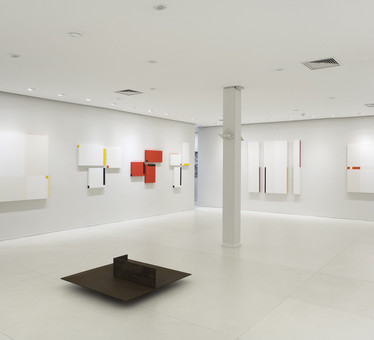Recent works by César Paternosto

São Paulo, Brasil
01/09/2015 - 30/09/2015
Pause, silence and contemplation, while necessary, are so rare in our daily lives that we forget their importance, until the moment we find something that surprises us or captures our attention.
In César Paternosto’s work, we can feel a disturbing tranquility. And not by chance, as the artist cites this perception as one of his intentions to reveal what he calls “the full emptiness”.
Achieving an aesthetic synthesis, full of content, is a process that demands a deep and long search from every artist.
The greatest challenge for an artist is to carry out the difficult mission of adding something new to the history of art, and for this it is necessary not only to look to the past, but also to try to accomplish something unprecedented in the present so that his work remains in the future.
For most artists linked to the current of geometric abstraction, the ground zero of this movement is the work Black Square (1915), by Russian Kazimir Malevich, which inaugurates suprematism and a new artistic reality, represented by geometric abstraction in counterpoint at the end of the figurative representation.
Artists such as Piet Mondrian, with works such as Composition in Red, Blue and Yellow (1930), or Josef Albers, with the series Structural Constellations and Homage to the Square (1950-76), expanded the opening started by Malevich.
In Brazil, this chain was inaugurated by São Paulo artists who formed Grupo Ruptura and by Cariocas from Grupo Frente, driven by the exhibition of works by the Swiss Max Bill.
Lygia Clark and Willys de Castro, for example, were Brazilian artists who questioned the tension between plane and three-dimensional space in their works, which led to innovative works such as Lygia’s Casulos (1959) and Active Objects (1959-62) by Willys.
The Venezuelan Jesús Soto, inspired by Mondrian, was one of the pioneers of kinetic art.
There is, therefore, an aesthetic affinity, or a chronological thread, that unites artists linked to geometric abstraction from different countries at various times in history.
In César Paternosto’s works, we find coherence and affinity with this common thread.
His life reflects this intense search, when he migrates from his hometown, La Plata, Argentina, to New York and more recently to Segovia, where he lives today.
In order to be able to see and fully understand the work of César Paternosto, we need not only to get close to it, but to move in front of it to discover what is hidden on the sides.
The concept of oblique or lateral view proposed by César Paternosto emerged in the late 1960s, when he lived in New York and created his first works in which the surface of the canvases presents a single plane of color, apparently empty, but full of subtleties if we pay attention.
The work calls us to pause to appreciate it. I invite everyone to participate in this experience.